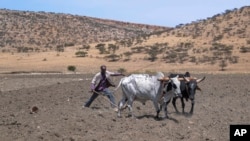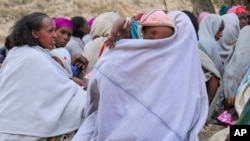The merciless realities of conflict and drought appear to have merged for Tinseu Hiluf, a widow residing within the arid depths of Ethiopia’s Tigray area who’s elevating 4 kids left behind by her sister’s current demise in childbirth.
A two-year conflict between federal troops and regional forces killed one in all her personal sons, the remainder of whom are already adults. And now, a scarcity of meals stemming from the area’s drought has left the youngest of the kids she is elevating malnourished.
She tries to forage seeds among the many scarce greenery of the desert’s yellow, rocky panorama. However she not too long ago resorted to touring to the close by Finarwa well being middle in southeastern Tigray to attempt to preserve the 1-year-old child alive.
“When hungry, we eat something from the desert,” she mentioned. “In any other case, nothing.”
She joined a number of different moms in search of assist on the middle within the distant administrative space of Nebar Hadnet. A mom of 5 complained that she had no breastmilk for her eight-month-old child. One other with 1-year-old twins mentioned she wanted sachets of child meals to maintain “my infants alive.”
Tigray is now peaceable, however conflict’s results linger, compounded by drought and a degree of help mismanagement that prompted the U.N. and the U.S. to quickly droop deliveries final yr.
As soon as-lush fields lie barren. Moms, faces etched with fear, watch helplessly as their kids weaken from malnutrition. Almost 400 folks died of hunger in Tigray and the neighboring Amhara area within the six months resulting in January, the nationwide ombudsman revealed in January, a uncommon admission of hunger-related deaths by a federal authorities.
Most of these deaths had been recorded in Tigray, dwelling to five.5 million folks.
Till the signing of a peace settlement in November 2022, the area was the scene of a lethal conflict between federal troops and forces loyal to the area’s now-ousted ruling get together. However months after the top of the battle, the U.N. and the U.S. halted meals help for Tigray due to a large scheme by Ethiopian officers to steal humanitarian grain.
An insufficient rising season adopted.
Persistent insecurity meant solely 49% of Tigray’s farmland was planted throughout the primary planting season final yr, in response to an evaluation by U.N. companies, NGOs and the regional authorities, and seen by the AP. Crop manufacturing in these areas was solely 37% of the anticipated whole due to drought. In some areas the proportion was as little as 2%, that evaluation mentioned.
The poor harvest prompted Tigray’s authorities to warn of an “unfolding famine” that might match the famine of 1984-5, which killed lots of of hundreds of individuals throughout northern Ethiopia, except the help response was scaled up. Meals deliveries to Tigray within the second half of final yr, however solely a small fraction of needy folks in Tigray are receiving meals help, humanitarian employees say.
Finarwa, a farming neighborhood of about 13,000 folks, is among the many worst-hit locations.
The city’s well being middle nonetheless has war-damaged tools and a few of its rooms seem deserted. Tadesse Mehari, the officer in command of the clinic, mentioned the dearth of meals at houses in the neighborhood has pressured kids to flee and beg in close by cities.
“Nothing right here to eat. So, for the sake of getting meals and to avoid wasting their lives, they’re displaced anyplace, removed from right here,” he mentioned. “So, on this space, lots of people are struggling. They’re starved. They’re dying as a result of absence of meals.”
Some native leaders, feeling helpless, have been turning their very own folks away
Hayale Gebrekedian, a Nebar Hadnet district chief for 5 years, listened to the pleas of villagers who streamed into his workplace one current afternoon. A widow named Serawit Wolde with 10 kids was in tears as she recounted that 5 of them had been falling in poor health from starvation.
“Please, any assist,” she instructed Hayale.
Hayale instructed the lady he had nothing to offer. “There merely is not any (meals),” he mentioned.
Hayale later instructed the AP, “This place was a supply of hope, even for these displaced by the conflict. We had sufficient for everybody, however now we won’t even feed ourselves.”
“The conflict took the whole lot,” he mentioned. There’s nothing left.”
Havale mentioned entry to water was a further problem. Of the 25 wells that when sustained the neighborhood and its animals, solely 5 remained purposeful. Individuals now trek for over an hour and a half to entry water, he mentioned.
The area’s drought has meant that some areas that normally get about 60 days of rain in the course of the wet season have seen only some.
Some farmers aren’t giving up.

Haile Gebre Kirstos, 70, continued to plough his parched land and plant sorghum in a village in Messebo, though rain fell “solely two days over the past wet season,” he mentioned.
As soon as lush and teeming with livestock, the land is now a barren expanse, but he remained hopeful even after the failure of the earlier harvest.
Though the plowing normally would not start till the wet season in Could or June, this yr he began the work early, pushed by excessive want. He spoke of farmers who’ve bought their oxen and farming instruments to feed their households.
For him, the reminiscence of the Eighties famine is haunting. “It affected your complete area then,” he mentioned. “Now, in some districts, it is both as unhealthy because the Eighties, and even worse.”

